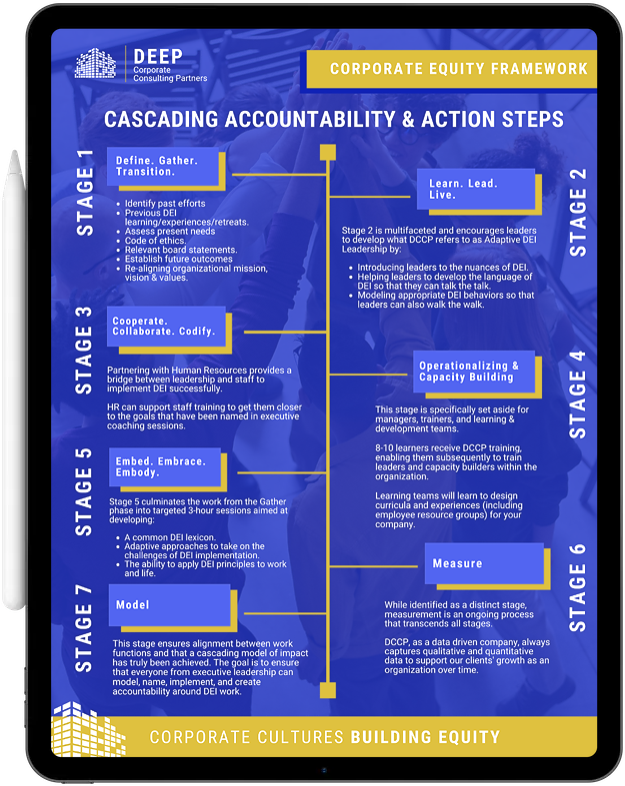
THE DCCP Corporate Equity Framework is a two-phase process with seven key stages.
These stages leverage the best practices in creating, operationalizing, and sustaining equitable culture. The Framework is broken into two phases of impact, Cascading Accountability and Cascading Action.
Cascading Accountability Phase
We begin by operationalizing our work at the executive level. This phase kicks off with C-suite leaders defining DBEI work. The cascading accountability phase supports a core group of leaders (identified by your organization) in
- defining the DBEI work;
- naming and creating a visioning document/strategic vision for DBEI, and
- understanding how to contextualize DBEI practices for organizational structures and operations.
The cultural gathering phase is crucial to our team’s effort to customize the model that will guide the implementation of your cultural strategy. This is a 10-hour phase wherein the DCCP team understands your former DBEI efforts while establishing your current DBEI needs.
Things that are helpful for us to review:
- The code of ethics, mission, and vision
- Any DBEI-related board statements that might be relevant and have been released.
- Any comments about DBEI from organizational leadership
- Previous DBEI learnings/experiences/retreats
Our SUITE training series is the kickoff to work within your organization. Given the level of commitment needed to ensure the successful implementation of DBEI within your organization, leaders must be well-versed in the cultures of equity, aware of the nuances of DBEI as they pertain to your organization, and possess the dexterity to model DBEI standards. Corporate leaders need time to grapple with this work in transformative spaces, an endeavor that will eventually culminate in their ability to leverage what DCCP calls Adaptive DBEI Leadership.
When codified, DBEI work, with HR backing, can support staff training, thus providing necessary stability to facilitate the achievement of the goals that have been named during the executive coaching sessions.
(For HR Teams) The goal of this series is to support you in understanding how to both operationalize and enact a culture of DBEI.
- Operationalize: What does this mean for our company? What is the culture we are hoping to create?
- Phase 2- Enact/Hire: What does this mean in practice for the staff? What does this mean as we scale/grow?
This phase of our work is all about building the internal capacity of your organization over time by embedding a perpetual culture of learning into your company.
Specifically designed for managers, trainers, and teams tasked with learning and development, the Operationalize phase is for a cohort of 8-10 learners who will be thoroughly trained by DCCP to execute the training of leaders and capacity builders within the organization. Furthermore, through rigorous and extensive learning spread out over the course of forty (40) hours, this cohort will be well-equipped to design curricula and create learning experiences (including employee resource groups) for your company.
Embody is at the heart of our long-term impact model. It is not simply enough for leaders to name the work, and for managers and learning teams to be trained to sustain the work.
Instead, the Embody phase is all about bringing your staff along this continuum of learning. These trainings, which take place in recurring three-hour blocks, focus on key DBEI learning within the context of renewed organizational support so that staff can develop the following: a working DBEI vocabulary; intimate learning experiences to process difficult work in DBEI; and knowledge of how to enact DBEI culture in their individual lives and within their teams. These sessions are customized to meet the organization’s specific needs as identified by the needs assessment and SWOT conducted during the Gather phase.
The one constant throughout the two-stage, seven-phase contiguous process of DBEI work is measurement.
DCCP, as a data driven company, is always capturing both qualitative and quantitative data to support clients in naming, quantifying, and qualifying their growth as an organization over time to assess the degree to which DBEI has taken hold while simultaneously probing for the existence of vulnerabilities in need of shoring up to maintain and perpetuate DBEI more efficaciously.
At its core, the impetus for implementing a sustainable culture of DBEI is employee driven; nevertheless, such change successfully takes hold when employees see coveted principles, ethics, and practices modeled by those in positions of leadership.
Such commitment to change shown at the top doesn’t simply trickle down throughout the organization; it permeates organizational culture and spreads concentrically to envelop any and every employee within proximity. This truest form of authenticity strongly correlates to the sustainability of DBEI work. The Model phase is a reciprocal analysis of the culture that has been created using our framework to ensure alignment between your organization’s work functions and the probability that the cascading model of impact has been achieved.
Cascading Action Phase
This phase is ongoing throughout our engagement with DBEI work and usually involves partnering with the existing HR team or a proxy HR to support an organization in designing and creating DBEI based practice/cultural practice. Deepening the partnership with human resources is integral to sustaining DBEI work.
Download Our Framework Infographic
Review The DCCP Framework seamlessly with your team buy downloading the infographic version.

Ready to get started?
Interested in positioning your company further along the DBEI spectrum? Your journey starts here.